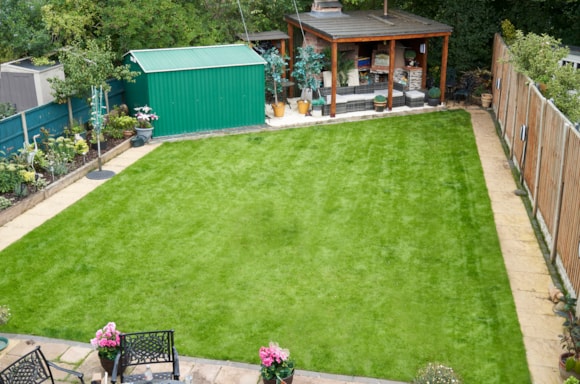
Spring is the perfect time to start caring for your lawn to ensure you have healthy and lush green grass throughout the year. Although grass is known for its resilience over winter, and let’s face it, it’s been a wet one, it still requires annual maintenance to thrive and look its absolute best. Johnsons, the UK’s oldest and most trusted lawn seed brand, offers a comprehensive guide to sowing and overseeding to achieve a healthy and thriving lawn.
Getting started with aeration
The first step in maintaining your lawn is to ensure that it is free from debris and other unwanted materials. This can be achieved by raking the lawn to remove leaves, twigs, moss weeds and other debris that may have accumulated over the winter months.
After you have cleared your lawn of any debris, the next step is to evaluate the condition of the grass. Following a rainy winter that has resulted in flood warnings all over the country, it is crucial to aerate the lawn as part of your spring lawn care routine. This is because the soil will likely be highly compacted after winter due to the constant rainfall, debris weight on the surface, and low levels of root growth during the cold months.
If you skip aerating, you run the risk of drainage problems and water pooling if you have an uneven lawn leading to weaker grassroots. Aerating the lawn is an easy task, and you can use aeration shoes, an aerator, or a garden fork. It is recommended to spike the lawn at least three inches deep and no more than three inches apart.
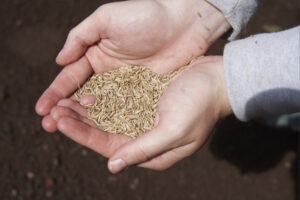
Seed like a professional
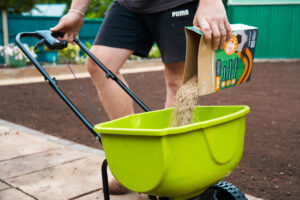
It is essential to check for bare or thinning patches, as these areas will require overseeding. Johnsons recommends using a high-quality seed mix that is suited to your lawn’s specific needs.
For those with children who love to play outside or those with pets, Tuffgrass is the perfect choice. It’s a hard-wearing grass that can handle the wear and tear of frequent foot traffic whilst the fine-leaved dwarf Perennial Ryegrass is resistant to dog urine patches. If you’re looking for a more deluxe lawn that will be the envy of your neighbours, Luxury Lawn is the way to go with a beautiful, lush finish.
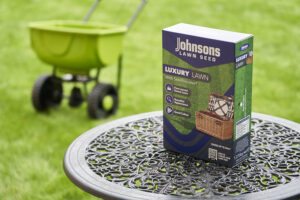
If your lawn faces north or is overlooked by trees or walls, Shady Place is the perfect solution as it creates a dense coverage that can handle low light conditions. Meanwhile, if you’re in a hurry to get your lawn established, Quick Lawn with Accelerator is a great option.
To prepare your lawn, start by raking the soil thoroughly until it is fine and crumble to ensure that the seeds have good contact with the soil. After you’ve sown the area needed, rake the lawn seeds in gently, making sure they are all beneath the soil surface, where they can germinate and grow. Tread the area over lightly to firm the soil and ensure good seed-to-soil contact. This will help to keep the seeds in place and protect them from being washed away by rain or wind.
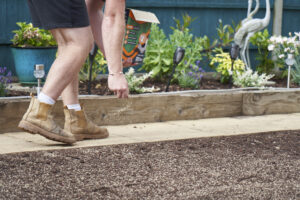
Watering for successful germination
Water your newly seeded grass immediately to ensure moist soil and initiate germination. Keep the soil consistently moist, but not waterlogged, by light watering several times a day, especially in warm and dry conditions. Use gentle watering methods via a sprinkler or hose, and water in the early morning or late afternoon. Check soil moisture frequently, avoid overwatering, and gradually reduce watering frequency as the grass seedlings grow. Continue to water as needed even after the grass is established and be sure to adjust the watering schedule based on the temperamental UK weather.
Newly germinated grass care
We recommend holding off on mowing newly germinated grass until it reaches a height of 2 to 3 inches. Set your mower blade to its highest setting and only remove the top third of the grass to prevent damage to the young grass and allow it to develop a strong root system.
Be on the lookout for weeds that may compete with the new grass for nutrients, water, and sunlight. Pull out any weeds by hand, as needed, but be careful not to disturb the young grass plants. We also suggest minimising foot traffic on your newly germinated grass until it has been fully established to avoid damaging the young roots.
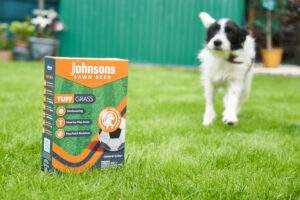
Feeding
When taking care of your lawn, it’s important to remember to apply a slow-release fertiliser feed after the initial mowing, as this will provide essential nutrients for the lawn’s development. We recommend Johnsons’ Super Smart Lawn Feed, which will revive tired-looking turf that has suffered from the wet weather conditions. It contains three naturally occurring ingredients: Azospirillum bacteria to feed your lawn, seaweed micronutrients to make the grass green, and mycorrhizae to increase root development.
Neudorff’s Organic CleanLawn is another good fertiliser option. It contains naturally occurring mycorrhiza fungi and soil-revitalising microorganisms. It ensures particularly strong and healthy roots and plants, resulting in a thicker, greener, drought-resistant lawn that naturally suppresses moss and weeds.
Following Johnsons’ easy steps, you can get your lawn back to good health after winter, ready for summer enjoyment and outdoor gatherings with friends and family.
Help keep news FREE for our readers
Supporting your local community newspaper/online news outlet is crucial now more than ever. If you believe in independent journalism, then consider making a valuable contribution by making a one-time or monthly donation. We operate in rural areas where providing unbiased news can be challenging. Read More About Supporting The West Wales Chronicle





















